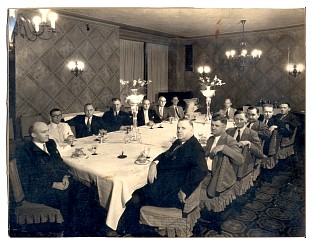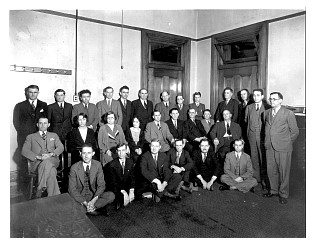Two Group Photos in Louisville, Kentucky
(click on image for enlargement)
The Tax and Trade Bureau History
By the turn of the century, the Bureau continued to make improvements. Development of its enforcement team was also bolstered with help from the ratification of the Eighteenth Amendment to the Constitution in 1919. This, in combination with the Volstead Prohibition Enforcement Act of that year, brought to prominence officers—”revenoors”—charged with investigating criminal violations of the Internal Revenue law, including the illicit manufacturing of liquors. By 1920, the unit had coalesced into the Prohibition Unit. Evolution of this unit reflects the difficulty of enforcing a nation-wide ban on the "manufacture, sale or transportation of intoxicating liquors for beverage purposes." On April Fool's Day, 1927, Treasury elevated the Prohibition Unit to Bureau status within the Department. However, Congress was impatient with the results and on July 1,1930, it transferred "the penal provisions of the national prohibition act" from Treasury's Bureau of Prohibition (which then ceased to exist) to the Department of Justice's new Bureau of Prohibition—with an important exception: tax-related and regulatory activities, "the permissive provisions," remained at Treasury, under a new Bureau of Industrial Alcohol. The most illustrious enforcer during that tumultuous era was Eliot Ness, the "T[reasury]-man," who toppled Chicago's organized-crime king Al Capone on tax-evasion charges.
The Twenty-first Amendment to the Constitution, repealing Prohibition, achieved ratification with unanticipated speed by December 5, 1933, catching Congress in recess. As an interim measure to manage a burgeoning legitimate alcohol industry, by executive order under the National Industrial Recovery Act, President Franklin D. Roosevelt established the Federal Alcohol Control Administration (FACA). FACA, in cooperation with the Departments of Agriculture and Treasury, endeavored to guide wineries and distilleries under a system based on brewers' voluntary codes of fair competition. FACA was relieved of its burden and effectively vanished from history after just twenty months, when President Roosevelt signed the Federal Alcohol Administration (FAA) Act in August 1935 and Treasury once more found itself regulating the alcohol industry.
A Brief History of Federal Firearms Enforcement
After the Civil War, revenue agents battled moonshiners throughout the South in some of the bloodiest opposition ever to federal law enforcement. Revenue agents and deputy U.S. marshals by the score were killed as they roamed the hills and hollows searching out illicit stills. Prohibition changed the government's focus from taxing whiskey to banning it, yet the revenue agent's job remained as dangerous. After experimenting in social adjustment a dozen years, Prohibition was rescinded. Spawned by the 1933 repeal of Prohibition, the Alcohol Tax Unit was established as a tax-collecting branch within the Internal Revenue Service (IRS). Continued concern over the violent, organized mobs that plagued the major cities compelled the federal government to try to curb the gangsters' ability to arm themselves. Rather than ban outright the purchase of machine guns and sawed-off shotguns-the weapons of choice for the mobsters-Congress in 1934 simply imposed a tax those weapons. Paying the tax required registering the weapon. The registration requirement was intended to discourage ownership of such weapons without outlawing them. No self-respecting gangster would want to register, much less pay the tax, on his Tommygun. Their evasion of the tax gave the government another legal tool to use in arresting the gangsters and breaking up the mobs.
Because it was a tax rather than a prohibition, it fell to Treasury to enforce the law as part of Treasury's role in collecting all funds due the government. Within Treasury, the Alcohol Tax Unit seemed the logical branch to enforce the new law. Registering and taxing stills required many of the same procedures and investigatory talents that would be needed to register and tax weapons. In the end, the new assignment proved comparatively easy. The unit was not overwhelmed with registrations nor by the 1940s were the investigations into evasions of the tax very time-consuming. As the gangsters declined in number and power, so did their use of machine guns and sawed-off shotguns. Enforcing the alcohol taxes again occupied most of the unit's attention.
In 1951, the Alcohol Tax Unit began enforcing federal taxes on tobacco, thus prompting a name change in 1952 to the Alcohol and Tobacco Tax Division. Once again, the logic seemed to be that collecting the tax on tobacco closely resembled the work necessary to collect the tax on alcohol, machine guns, and sawed-off shotguns. The 1968 passage of the Omnibus Crime Control and Safe Streets Act and the Gun Control Act expanded the IRS unit's jurisdiction to the criminal use of explosives and bombs. The new laws also defined specific federal offenses involving firearms, including transportation across state lines and use in organized crimes. In recognition of this new enforcement responsibility, the Alcohol and Tobacco Tax Division changed its name to the Alcohol, Tobacco, and Firearms Division (ATFD). Two years later, Congress passed the Explosives Control Act defining certain bombings and acts of arson as federal crimes. It assigned jurisdiction for enforcing this new law to ATFD. With these expanded responsibilities. the Treasury Department on July 1, 1972 created the Bureau of Alcohol, Tobacco, and Firearms under the general oversight of the Assistant Secretary of the Treasury for Enforcement, Tariffs and Trade, and Operations. For the past twenty-one years, ATF has enforced the collection of federal taxes on alcohol and tobacco and the federal controls and regulations on firearms, with particular attention to their use by criminals.
Home
1 of 1

